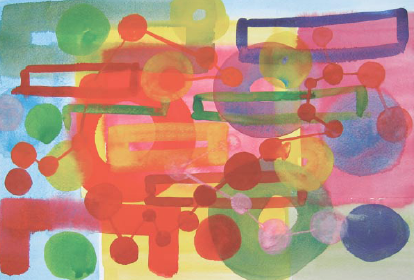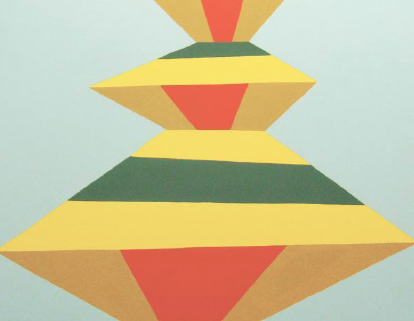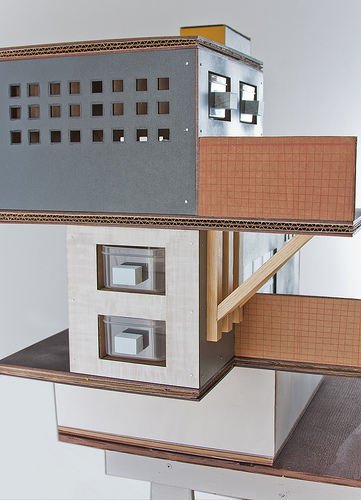
Richard Timperio “Untitled Watercolor” (2010). Photo courtesy Art 101
“What Art Can Do”
Art 101, 101 Grand St., through 10/17
The six artists in “What Art Can Do” have at least one thing in common (and it isn’t their artistic styles): they all run galleries in Williamsburg. Richard Timperio, who heads the Sideshow gallery, contributes lively watercolors of colorful rings and rectangles. His taste for audacious abstraction becomes evident in his own paintings as well as in the work of artists he exhibits at his gallery. Daniel Aycock (Front Room Gallery) offers an animation called “Diagram of a Perpetual Motion Machine Powered by Art World Personalities” — basically a Ferris-wheel contraption with attached nodules, spinning in an endless loop. Aycock and the others in this show are “art world personalities.” Are they part of the machine?
Ellen Rand, the art world personality who put this show together, told me that Todd Rosenbaum (Hogar Collective) had more or less given up on making art before she asked him to contribute something. Rosenbaum found the inspiration to create several cloud-like cutouts on painted paper. His strongest piece is a row of dark drippy blotches backed by fluorescent hues that are only visible as glowing reflections on the wall behind them. It’s a deceptively simple example of the physical power of color. For his part, Randall Harris (Figureworks) has drawn nudes composed of geometric whirls and slashes filled in with sparse tinting. Harris, evidently, can portray the human figure with as much gusto as any artist that Figureworks represents.
Parker’s Box lent two talented artists / gallerists to the exhibition, Kathleen Vance and Alun Williams. Inside a black plastic case on wheels lives a spritely botanical garden devised by Vance. The self-contained piece —a literal landscape —has everything it needs to survive: light source, dirt, plants, flowing stream. Williams reveals both a keen wit and polished brush skills in his portrait series, which puts 19th-century figures Victorine Meurent and Jules Verne in a variety of comical situations. (Meurent was a model and muse for Manet. Decades later, Picasso painted her likeness in modernist variations on Manet’s masterpieces. Now, Williams appropriates both artists’ styles for his own portraits of the long-dead model.) One painting places Meurent on the red carpet at the Oscars. She poses for cameras as Verne lingers nearby. (Verne, I should note, is depicted in all these paintings as a red blob, which Williams based on an incidental paint splatter he had noticed on Rue Jules Verne in Paris.) While the overlap of historical references might leave a reviewer breathless, the paintings themselves are simply winsome.
Kudos to the folks in this show for having the energy to support other artists and take some time for their own creative output. May their perpetual-motion art machines keep on turning.
Don Christensen, “Digitalized”
Sideshow, 319 Bedford Ave., through 10/10
Don Christensen was a drummer in the post-punk No Wave scene of the late 1970s and early 1980s, and his acute sense of rhythm comes through strongly in his paintings. Spunky, bright shapes and bold bars of color bounce across the works as if grooving to their own (askew) beat.

Don Christensen “TipTop,” acrylic on canvas (2010). Photo courtesy Sideshow
They are minimal but not minimalist. Christensen’s shapes have character and vivacity, and sometimes the shapes become objects, as in “Charlie Ringo’s Crown,” in which spikes of green, yellow, and red form a regal coronet on a gold background. The hand-painted lines wobble a bit where one block of color abuts another, bringing a humanizing touch to the “digitalized” pieces. (His creative process involves making a drawing by hand, scanning the drawing into a computer, reworking the piece in Photoshop, and painting the outcome on canvas or wood or furniture.) Christensen’s color combinations and juxtaposing shapes are off-kilter enough to joggle the eyes, but this offness is precisely what makes his paintings oh-so-right.
Monica Martinez, “Wurmhaus”
EyeLevel BQE, 364 Leonard St., through 10/15
Land for grazing cattle is becoming scarce; chicken eggs can carry salmonella; pollutants contaminate once bountiful fishing waters. With so much devastation afflicting animal-based food supplies, where will we get protein in the future? Monica Martinez wants us to grow it in our homes, in the form of mealworms. Her show at EyeLevel BQE demonstrates how we can store the larvae in plastic drawers, with slices of carrot, bran flakes, chunks of sponge, and cut egg cartons to keep them alive and happy. To hold the drawers, Martinez has constructed sleek, rectilinear insect apartment buildings inspired by the vertical-living ideal of Walter Gropius, founder of Bauhaus.

Monica Martinez “Wurmhaus Headquarters”
One such structure has been erected in the gallery, complete with balconies, frosted windows, and, yes, drawers crawling with mealworms and darkling beetles, the adult life stage of mealworms. Tiny cardboard models of future utopian constructions sit on nearby shelves. Apparently, we will have options in mealworm-storage design. The idea that average citizens would cultivate insects in miniature architectural marvels seems a bit hokey, but to prove she’s not a dreamer Martinez offers basic “Wurmhaus” kits for attendees to assemble at home. Walter Gropius would be proud of this utilitarian gesture.
Leave a Reply